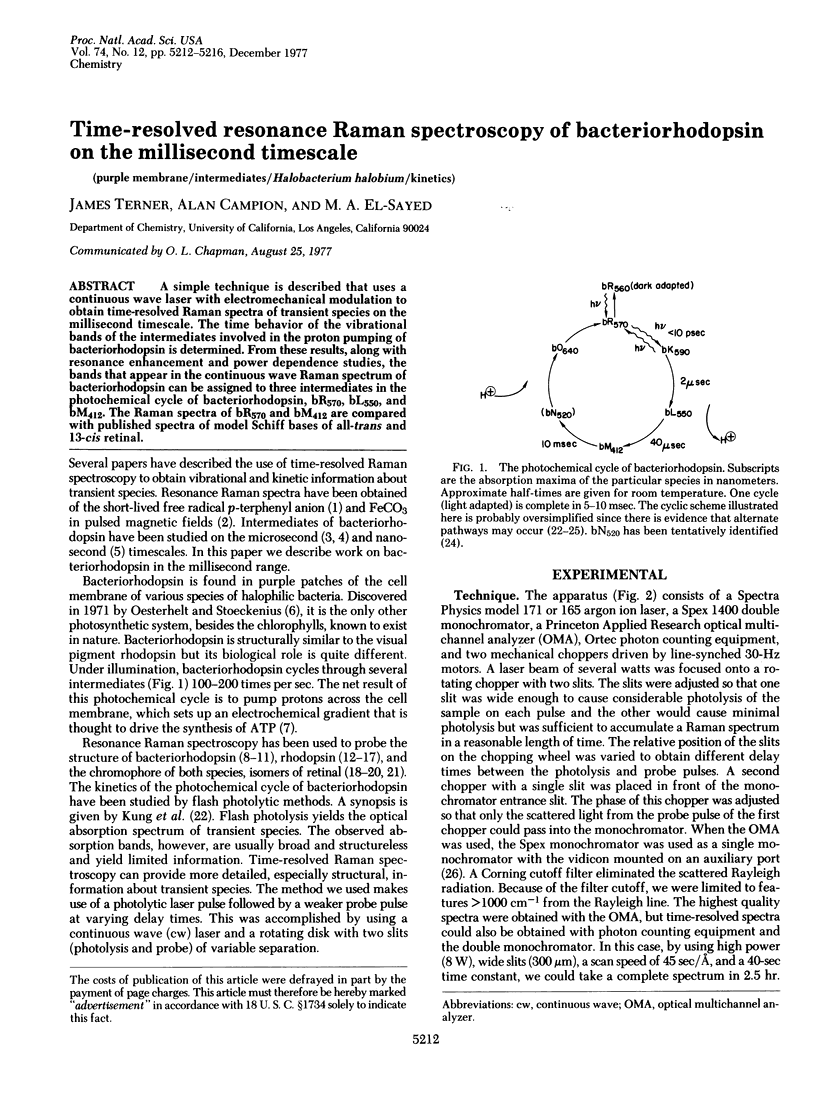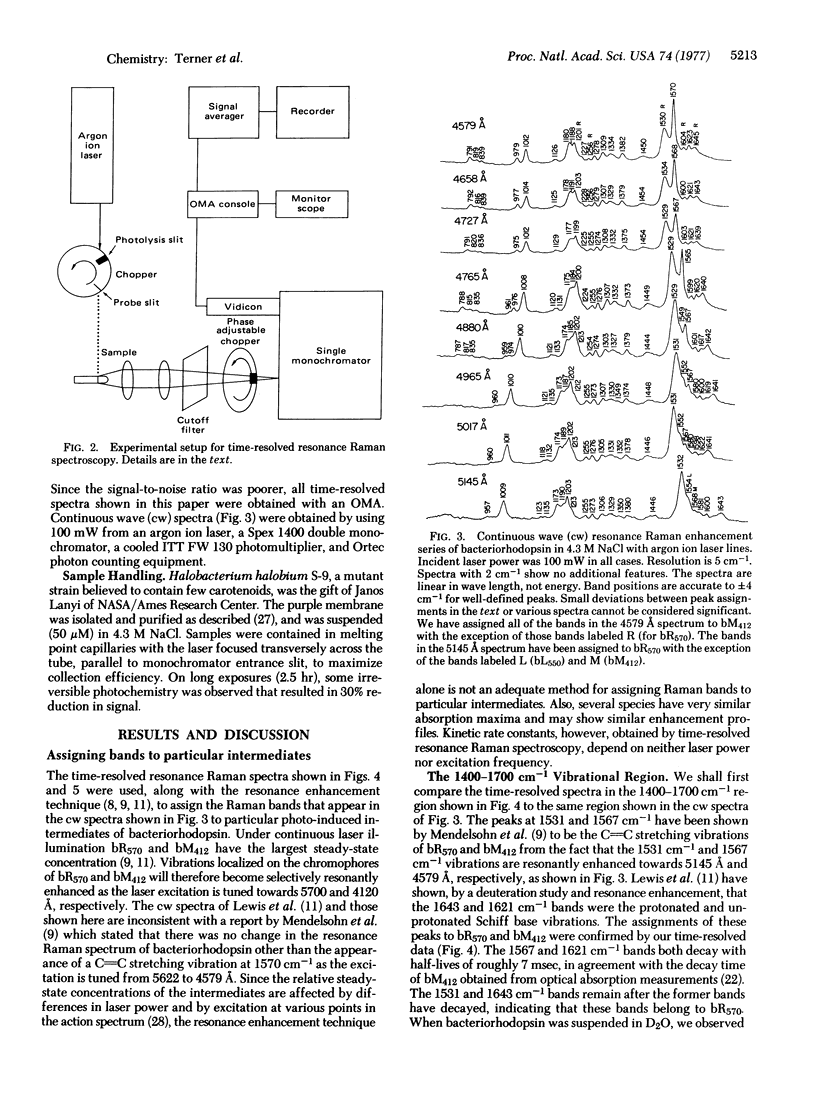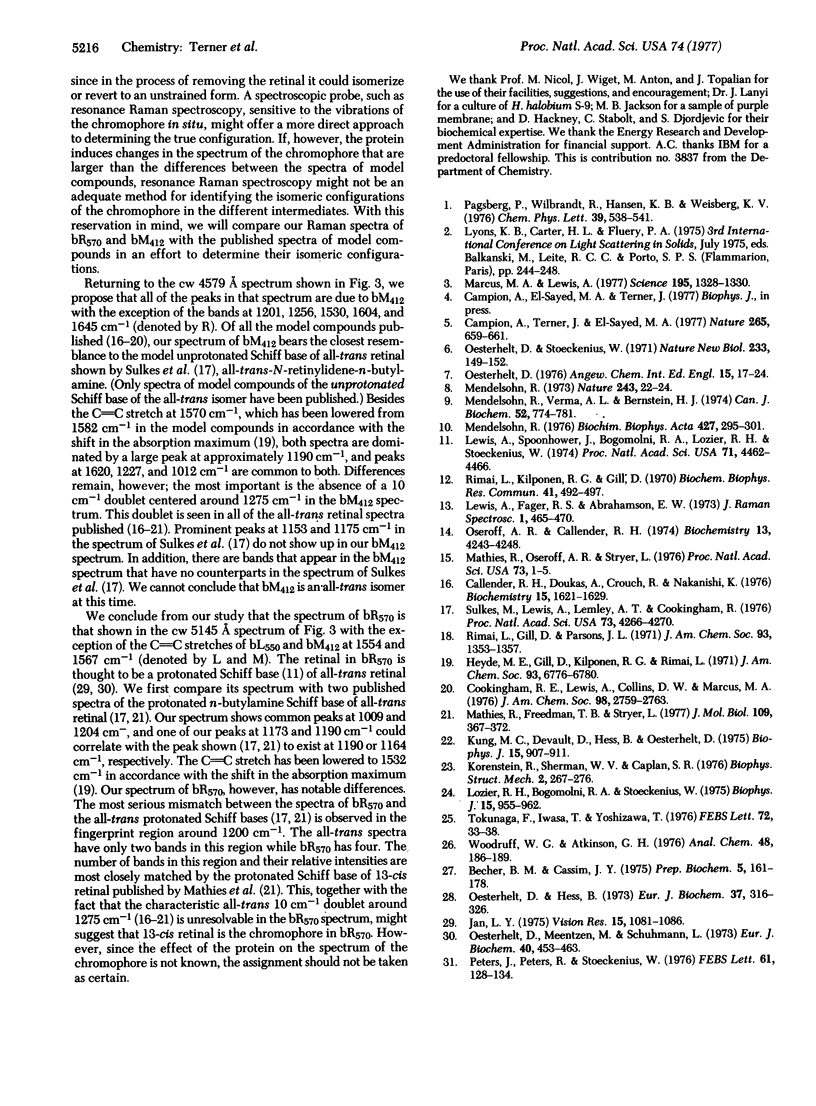Abstract
A simple technique is described that uses a continuous wave laser with electromechanical modulation to obtain time-resolved Raman spectra of transient species on the millisecond timescale. The time behavior of the vibrational bands of the intermediates involved in the proton pumping of bacteriorhodopsin is determined. From these results, along with resonance enhancement and power dependence studies, the bands that appear in the continuous wave Raman spectrum of bacteriorhodopsin can be assigned to three intermediates in the photochemical cycle of bacteriorhodopsin, bR570, bL550, and bM412. The Raman spectra of bR570 and bM412 are compared with published spectra of model Schiff bases of all-trans and 13-cis retinal.
Full text
PDF




Selected References
These references are in PubMed. This may not be the complete list of references from this article.
- Becher B. M., Cassim J. Y. Improved isolation procedures for the purple membrane of Halobacterium halobium. Prep Biochem. 1975;5(2):161–178. doi: 10.1080/00327487508061568. [DOI] [PubMed] [Google Scholar]
- Callender R. H., Doukas A., Crouch R., Nakanishi K. Molecular flow resonance Raman effect from retinal and rhodopsin. Biochemistry. 1976 Apr 20;15(8):1621–1629. doi: 10.1021/bi00653a005. [DOI] [PubMed] [Google Scholar]
- Campion A., Terner J., El-Sayed M. A. Time-resolved resonance Raman spectroscopy of bacteriorhodopsin. Nature. 1977 Feb 17;265(5595):659–661. doi: 10.1038/265659a0. [DOI] [PubMed] [Google Scholar]
- Chu Kung M., DeVault D., Hess B., Oesterhelt D. Photolysis of bacterial rhodopsin. Biophys J. 1975 Sep;15(9):907–911. doi: 10.1016/S0006-3495(75)85864-4. [DOI] [PMC free article] [PubMed] [Google Scholar]
- Cookingham R. E., Lewis A., Collins D. W., Marcus M. A. Preresonance Raman spectra of crystals of retinal isomers. J Am Chem Soc. 1976 May 12;98(10):2759–2763. doi: 10.1021/ja00426a014. [DOI] [PubMed] [Google Scholar]
- Hansen C. M., Brown M. L., Trontell M. Effects on pregnant adolescents of attending a special school. J Am Diet Assoc. 1976 Jun;68(6):538–541. [PubMed] [Google Scholar]
- Heyde M. E., Gill D., Kilponen R. G., Rimai L. Raman spectra of Schiff bases of retinal (models of visual photoreceptors). J Am Chem Soc. 1971 Dec 15;93(25):6776–6780. doi: 10.1021/ja00754a012. [DOI] [PubMed] [Google Scholar]
- Jan L. Y. The isomeric configuration of the bacteriorhodopsin chromophore. Vision Res. 1975 Oct;15:1081–1086. doi: 10.1016/0042-6989(75)90004-8. [DOI] [PubMed] [Google Scholar]
- Korenstein R., Sherman W. V., Caplan S. R. Kinetic isotope effects in the photochemical cycle of bacteriorhodopsin. Biophys Struct Mech. 1976 Dec 22;2(3):267–276. doi: 10.1007/BF00535372. [DOI] [PubMed] [Google Scholar]
- Lewis A., Spoonhower J., Bogomolni R. A., Lozier R. H., Stoeckenius W. Tunable laser resonance raman spectroscopy of bacteriorhodopsin. Proc Natl Acad Sci U S A. 1974 Nov;71(11):4462–4466. doi: 10.1073/pnas.71.11.4462. [DOI] [PMC free article] [PubMed] [Google Scholar]
- Lozier R. H., Bogomolni R. A., Stoeckenius W. Bacteriorhodopsin: a light-driven proton pump in Halobacterium Halobium. Biophys J. 1975 Sep;15(9):955–962. doi: 10.1016/S0006-3495(75)85875-9. [DOI] [PMC free article] [PubMed] [Google Scholar]
- Marcus M. A., Lewis A. Kinetic resonance Raman spectroscopy: dynamics of deprotonation of the Schiff base of bacteriorhodopsin. Science. 1977 Mar 25;195(4284):1328–1330. doi: 10.1126/science.841330. [DOI] [PubMed] [Google Scholar]
- Mathies R., Freedman T. B., Stryer L. Resonance Raman studies of the conformation of retinal in rhodopsin and isorhodopsin. J Mol Biol. 1977 Jan 15;109(2):367–372. doi: 10.1016/s0022-2836(77)80040-5. [DOI] [PubMed] [Google Scholar]
- Mathies R., Oseroff A. R., Stryer L. Rapid-flow resonance Raman spectroscopy of photolabile molecules: rhodopsin and isorhodopsin. Proc Natl Acad Sci U S A. 1976 Jan;73(1):1–5. doi: 10.1073/pnas.73.1.1. [DOI] [PMC free article] [PubMed] [Google Scholar]
- Mendelsohn R. Resonance Raman spectroscopy of the photoreceptor-like pigment of Halobacterium halobium. Nature. 1973 May 4;243(5401):22–24. doi: 10.1038/243022a0. [DOI] [PubMed] [Google Scholar]
- Mendelsohn R. Thermal denaturation and photochemistry of bacteriorhodopsin from Halobacterium cutirubrum as monitored by resonance Raman spectroscopy. Biochim Biophys Acta. 1976 Mar 18;427(1):295–301. doi: 10.1016/0005-2795(76)90305-6. [DOI] [PubMed] [Google Scholar]
- Mendelsohn R., Verma A. L., Bernstein H. J., Kates M. Structural studies of bacteriorhodopsin from Halobacterium cutirubrum by resonance Raman spectroscopy. Can J Biochem. 1974 Sep;52(9):774–781. doi: 10.1139/o74-110. [DOI] [PubMed] [Google Scholar]
- Oesterhelt D. Bacteriorhodopsin as an example of a light-driven proton pump. Angew Chem Int Ed Engl. 1976 Jan;15(1):17–24. doi: 10.1002/anie.197600171. [DOI] [PubMed] [Google Scholar]
- Oesterhelt D., Hess B. Reversible photolysis of the purple complex in the purple membrane of Halobacterium halobium. Eur J Biochem. 1973 Aug 17;37(2):316–326. doi: 10.1111/j.1432-1033.1973.tb02990.x. [DOI] [PubMed] [Google Scholar]
- Oesterhelt D., Meentzen M., Schuhmann L. Reversible dissociation of the purple complex in bacteriorhodopsin and identification of 13-cis and all-trans-retinal as its chromophores. Eur J Biochem. 1973 Dec 17;40(2):453–463. doi: 10.1111/j.1432-1033.1973.tb03214.x. [DOI] [PubMed] [Google Scholar]
- Oesterhelt D., Stoeckenius W. Rhodopsin-like protein from the purple membrane of Halobacterium halobium. Nat New Biol. 1971 Sep 29;233(39):149–152. doi: 10.1038/newbio233149a0. [DOI] [PubMed] [Google Scholar]
- Oseroff A. R., Callender R. H. Resonance Raman spectroscopy of rhodopsin in retinal disk membranes. Biochemistry. 1974 Sep 24;13(20):4243–4248. doi: 10.1021/bi00717a027. [DOI] [PubMed] [Google Scholar]
- Peters J., Peters R., Stoeckenius W. A photosensitive product of sodium borohydride reduction of bacteriorhodopsin. FEBS Lett. 1976 Jan 15;61(2):128–134. doi: 10.1016/0014-5793(76)81019-8. [DOI] [PubMed] [Google Scholar]
- Rimai L., Kilponen R. G., Gill D. Resonance-enhanced Raman spectra of visual pigments in intact bovine retinas at low temperatures. Biochem Biophys Res Commun. 1970 Oct 23;41(2):492–497. doi: 10.1016/0006-291x(70)90533-4. [DOI] [PubMed] [Google Scholar]
- Sulkes M., Lewis A., Lemley A. T., Cookingham R. Modeling the resonance Raman spectrum of a metarhodopsin: implications for the color of visual pigments. Proc Natl Acad Sci U S A. 1976 Dec;73(12):4266–4270. doi: 10.1073/pnas.73.12.4266. [DOI] [PMC free article] [PubMed] [Google Scholar]
- Tokunaga F., Iwasa T., Yoshizawa T. Photochemical reaction of bacteriorhodopsin. FEBS Lett. 1976 Dec 15;72(1):33–38. doi: 10.1016/0014-5793(76)80807-1. [DOI] [PubMed] [Google Scholar]
- Woodruff W. H., Atkinson G. H. Vidicon detection of resonance Raman spectra: cytochrome c. Anal Chem. 1976 Jan;48(1):186–189. doi: 10.1021/ac60365a047. [DOI] [PubMed] [Google Scholar]


